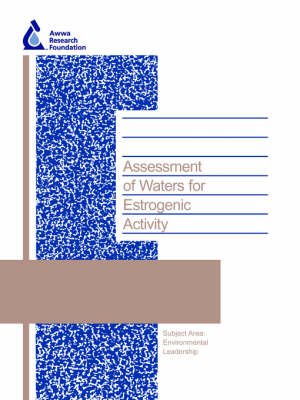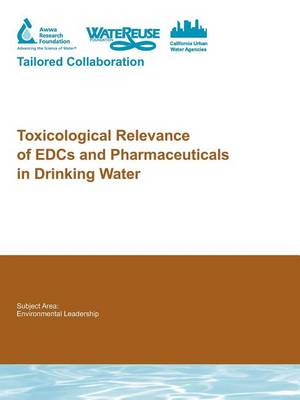Water Research Foundation Report
2 total works
Assessment of Waters for Estrogenic Activity
by Jocelyn D. C. Hemming, M. Barman, and J. Standridge
Published 1 January 2004
The goal of this research was to determine the occurrence of estrogenic activity in source waters, finished drinking waters, and industrial and municipal wastewater effluents. The research team planned to accomplish this goal by validating and optimizing the E-Screen assay, which would then be used to document the estrogenic activity in water samples. Additionally, caged fish studies and in lab exposure studies would be conducted on some of the same samples to assess estrogenic activity with an in vivo system. Using the E-Screen, the research team tested samples from over 70 drinking water facilities. A majority of the source waters (61%) had estrogen activities above the level of detection (0.029 ng/L). Drinking water treatment processes do remove activity; therefore, only 16% of finished waters had activities above the detection limit. Of the 27 wastewater treatment plant effluents tested, activity ranged from no activity to a sample with greater than 1,700 ng/L of activity. Vitellogenin levels were significantly increased in male fathead minnows in only two of the waters tested, both wastewater treatment plant effluents. Using the E-Screen, 90 finished water samples from 72 facilities were tested. Of the finished waters, 84% did not contain estrogenic activity above the level of detection (0.029 ng/L estradiol equivalents). Of the remaining 14 samples, 13 were below 0.27 ng/L. In contrast to the finished waters, the majority (61%) of source waters did have measurable estrogenic activity. Of the 105 surface or groundwater samples tested, 64 were above the detection limit of the assay. Again, the activities were fairly low, with only 10 waters having activities above 0.27 ng/L. Surface waters exhibited higher levels of estrogenic activity than did ground waters; however, 42% of the ground waters tested did have estrogenic activity. Twenty-seven wastewater treatment plant effluents were tested from 17 facilities. Estrogenic activity ranged from no activity (in seven of the effluents) to a sample with greater than 1,700 ng/L of activity. Fish exposure studies were completed at six facilities. No significant responses were found in fish exposed to the source or drinking water samples, but two WWTP effluents caused a significant vitellogenin induction. The low number of positive vitellogenin responses limited their comparison with the E-Screen. Originally published by AwwaRF for its subscribers in 2003.
Analytical technology has made it possible to detect and quantify nearly any compound known to humankind at diminishingly minute concentrations in water. Although the earliest reports of pharmaceuticals and steroid hormones in water date back nearly four decades, it is only within the past decade that the subject has come to the forefront of scientific and public attention. Today, we know definitively that trace levels of pharmaceuticals, potential EDCs, and other emerging contaminants do occur in source water, and to a lesser extent, in finished drinking water. Based on research thus far, it appears that many conventional and advanced treatment processes will greatly reduce the concentrations of these compounds. Nevertheless, considering the continued advancements in analytical technologies, today's non-detectable contaminants will be tomorrow's emerging contaminants. If presence/absence becomes our litmus test for risk and subsequent actions, treatment technology will be increasingly, and perhaps unnecessarily, costly and energy intensive. This is an especially important consideration due to the energy cost and greenhouse gas emissions of advanced treatment. For these reasons, it is of utmost importance to determine human health-based screening levels from which meaningful treatment goals and analytical detection limits can be established.
The primary objective of this project was to establish a suite of indicator pharmaceuticals and potential endocrine disrupting compounds (EDCs) to be used for evaluating the exposure and health implications from drinking water. A secondary objective was the development of robust analytical methods to identify and quantify the indicator compounds in raw and finished drinking water. The final objective was the evaluation of toxicity data with occurrence data in order to develop a human health risk assessment for indicator pharmaceuticals and potential EDCs in U.S. drinking waters. A suite of 62 indicator pharmaceuticals and potential EDCs were selected based upon literature reviews of potential for toxicity, propensity for occurrence, and analytical capability. Robust analytical methods utilizing isotope-dilution and tandem mass spectrometry were developed in order to monitor the raw and finished waters of 20 U.S. drinking water facilities with ng/L sensitivity. An in vitro bioassay was used to screen for estrogenicity in the same waters. A series of bottled waters and food and beverage items were also screened for estrogenicity for a benchmark comparison. Risk evaluations for exposure through drinking water were conducted for 16 pharmaceuticals, 10 potential EDCs, and 3 steroid hormones. ADIs were calculated using methods consistent with USEPA approaches for determining levels of exposure to environmental contaminants.
The primary objective of this project was to establish a suite of indicator pharmaceuticals and potential endocrine disrupting compounds (EDCs) to be used for evaluating the exposure and health implications from drinking water. A secondary objective was the development of robust analytical methods to identify and quantify the indicator compounds in raw and finished drinking water. The final objective was the evaluation of toxicity data with occurrence data in order to develop a human health risk assessment for indicator pharmaceuticals and potential EDCs in U.S. drinking waters. A suite of 62 indicator pharmaceuticals and potential EDCs were selected based upon literature reviews of potential for toxicity, propensity for occurrence, and analytical capability. Robust analytical methods utilizing isotope-dilution and tandem mass spectrometry were developed in order to monitor the raw and finished waters of 20 U.S. drinking water facilities with ng/L sensitivity. An in vitro bioassay was used to screen for estrogenicity in the same waters. A series of bottled waters and food and beverage items were also screened for estrogenicity for a benchmark comparison. Risk evaluations for exposure through drinking water were conducted for 16 pharmaceuticals, 10 potential EDCs, and 3 steroid hormones. ADIs were calculated using methods consistent with USEPA approaches for determining levels of exposure to environmental contaminants.

